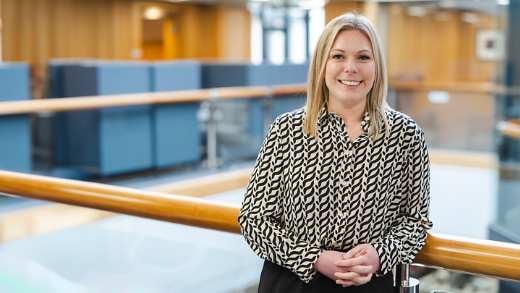...but nearly one in five women never check their breasts.
- 18% of women never check their breasts for signs of cancer
- 18% of women don’t know what to look for when checking their breasts
- In 2023 breast cancer accounted for over half (55%) of Aviva’s individual critical illness cancer claims for women and around three in five (61%) of cancer claims made by women on Aviva’s private healthcare
As we approach breast cancer awareness month, Aviva’s research1 reveals that the majority of women know what to look for but a worrying number are not checking for signs of cancer.
Figures show that over recent years around 56,000 women are diagnosed with breast cancer in the UK every year2. It’s therefore not surprising that breast cancer is still a leading cause of claim in women across Aviva’s private medical insurance and individual critical illness policies.
Spotting the signs of breast cancer early can help increase the chance of successful treatment.
Spotting the signs of breast cancer early can help increase the chance of successful treatment. Reassuringly, the research showed that on average women check their breasts around ten times a year. This figure increases with age, with women aged 50-71 years checking themselves just over 11 times a year. This is positive to see as most breast cancer cases tend to occur over the age of 50, although younger people can be affected.3
The positive trend continues when it comes to awareness of potential symptoms of breast cancer. Most women (82%) said they knew what to look for when checking their breasts. Awareness also increases with age, with almost nine in ten (88%) woman aged 50-71 years saying that they know what to look for.
However, the research revealed that not all women are vigilant. Just under one in five (18%) of women across all age groups said they never check their breasts.
Just under one in five (18%) women said that they don’t know what to look for when checking their breasts. This lack of awareness rises significantly in the younger age groups. Just over a quarter (27%) of women aged 25-34 years and over a third (34%) of 18-24 year old women said they didn’t know what to look for when checking their breasts for potential signs of cancer.
When prompted with a list, around three quarters of women recognised common signs of breast cancer such as a lump or swelling in the armpit (75%) or a lump or thickening of the breast tissue (76%).
However, awareness of less talked-about symptoms was lower among all female age groups. Around half (52%) agreed that pain or pulling in the nipple area or skin problems such as a rash around the nipple (43%) and/or red and flaky skin on the breast (42%) could be signs of breast cancer.
It’s reassuring that the majority of women recognise the benefits of early detection and the potentially worrying signs to look out for when checking their breasts. However, there are still those who aren’t as well informed, particularly in the younger age groups.
Dr Subashini M, Medical Director, Aviva UK Health said: “Much progress has been made when it comes to awareness of potential symptoms of breast cancer and the measures you can take to help aid early detection of any changes. However, it’s still a leading cause of health insurance and protection insurance claims for women.
“As with many cancers, early detection can help to improve the chances of successful treatment. Our breasts change at various times of the month, so it’s recommended that people check their breasts around once a month, just after their period. If they’re in menopause, then anytime is fine. It’s also important that women over 50 attend their regular mammogram offered as part of the NHS screening programme.
“It’s reassuring that the majority of women recognise the benefits of early detection and the potentially worrying signs to look out for when checking their breasts. However, there are still those who aren’t as well informed, particularly in the younger age groups. This is where activity such as workplace wellbeing programmes could really help engage employees of all ages.
“While the chance of getting breast cancer increases with age, it’s never too early to start looking out for changes in our breasts such as lumps in the breast or armpit, thickening of breast tissue and changes to the skin, nipple or shape of the breast. The earlier we start a positive habit, the more likely we are to continue it into later life.”
Amber Scott
Protection and Health, Regulation
-
Phone
-
+44 (0) 7384 230 662
-
-
Email
Media Enquiries:
References
1. The research was conducted by Censuswide with 2002 18+ nat rep general consumers in the UK between 21/08/24 - 23/08/24. Censuswide abide by and employ members of the Market Research Society which is based on the ESOMAR principles and are members of The British Polling Council.
2. Facts and figures | Breast Cancer UK
3. Breast Cancer: Symptoms, Stages, Diagnosis, Treatment | Patient Info
Useful resources
Notes to editors:
- We are the UK's leading diversified insurer and we operate in the UK, Ireland and Canada. We also have international investments in India and China.
- We help our 20.5 million (as at 31 December 2024) customers make the most out of life, plan for the future, and have the confidence that if things go wrong we'll be there to put it right.
- We have been taking care of people for more than 325 years, in line with our purpose of being 'with you today, for a better tomorrow'. In 2024, we paid £29.3 billion in claims and benefits to our customers.
- In 2021, we announced our ambition to become Net Zero by 2040, the first major insurance company in the world to do so. While we are working towards our sustainability ambitions, we recognise that while we have control over Aviva's operations and influence over our supply chain, when it comes to decarbonising the economy in which we operate and invest, Aviva is one part of a far larger global system. Nevertheless, we remain focused on the task and are committed to playing our part in the collective effort to enable the global transition. Find out more about our climate goals at www.aviva.com/sustainability/climate and our sustainability ambition and action at www.aviva.com/sustainability.
- Aviva is a Living Wage, Living Pension and Living Hours employer and provides market-leading benefits for our people, including flexible working, paid carers leave and equal parental leave. Find out more at https://www.aviva.com/about-us/our-people/
- As at 31 December 2024, total Group assets under management at Aviva Group were £407 billion and our estimated Solvency II shareholder capital surplus as at 31 December 2024 was £7.9 billion. Our shares are listed on the London Stock Exchange and we are a member of the FTSE 100 index.
- For more details on what we do, our business and how we help our customers, visit www.aviva.com/about-us
- The Aviva newsroom at www.aviva.com/newsroom includes links to our spokespeople images, podcasts, research reports and our news release archive. Sign up to get the latest news from Aviva by email.
- You can follow us on:
- X: www.x.com/avivaplc
- LinkedIn: www.linkedin.com/company/aviva-plc
- Instagram: www.instagram.com/avivaplc
- For the latest corporate films from around our business, subscribe to our YouTube channel: www.youtube.com/user/aviva
















